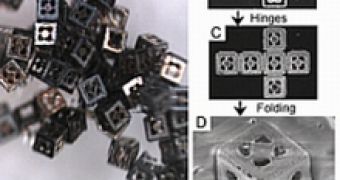Doctors all over the world are trying to improve the efficiency of the administered drugs and a team of researchers from the Johns Hopkins University has devised a new delivery system for medications and cell therapy consisting in a self- assembling cube-shaped perforated container, no larger than a dust speck.
The relatively inexpensive microcontainers can be mass-produced through a process that mixes electronic chip-making techniques with basic chemistry.
Because of their metallic nature, the cubic container's location in the body could easily be tracked by magnetic resonance imaging.
"Our group has developed a new process for fabricating three-dimensional micropatterned containers for cell encapsulation and drug delivery," said David H. Gracias, who led the lab team.
"We're talking about an entirely new encapsulation and delivery device that could lead to a new generation of 'smart pills.' The long-term goal is to be able to implant a collection of these therapeutic containers directly at the site or an injury or an illness."
The researchers use metallic solder to form hinges along the edges between adjoining squares. When the flat shapes are heated briefly in a lab solution, the metallic hinges melt. High surface tension in the liquified solder pulls each pair of adjoining squares together like a swinging door.
When the process is completed, they form a perforated cube. When the solution is cooled, the solder hardens again, and the containers remain in their box-like shape.
"To make sure it folds itself exactly into a cube, we have to engineer the hinges very precisely," Gracias said. "The self-assembly technique allows us to make a large number of these microcontainers at the same time and at a relatively low cost."
The tiny cubes are coated with a very thin layer of gold, so that they are unlikely to pose toxicity problems within the body. The microcontainers have not yet been implanted in humans or animals, but the researchers have conducted lab tests to demonstrate how they might work in medical applications.

 14 DAY TRIAL //
14 DAY TRIAL //